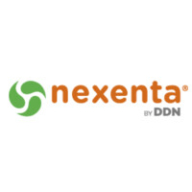


Nexenta and LizardFS are competing in the software-defined storage market. Nexenta holds a slight advantage in customer satisfaction with pricing and support, while LizardFS is often considered superior due to its robust features.
Features: Nexenta is recognized for enterprise-grade capabilities supporting a wide range of storage protocols and offering advanced data management functionalities. It provides a comprehensive feature set catering to diverse enterprise needs. LizardFS is noted for its scalable architecture suited for handling large data volumes efficiently and strength in flexibility and data redundancy aimed at enhancing scalability.
Ease of Deployment and Customer Service:Nexenta offers a streamlined deployment process with strong customer support, facilitating easy integration for enterprises. LizardFS, while praised for its technical documentation, often requires more configuration and setup, potentially increasing the deployment timeline.
Pricing and ROI: Nexenta generally involves a higher setup cost but offers a compelling return on investment through extensive features and support. LizardFS, with moderate initial costs, provides a scalable solution promising long-term savings, especially for large-scale deployments.
| Product | Market Share (%) |
|---|---|
| Pure Storage FlashBlade | 4.1% |
| Nexenta | 1.4% |
| LizardFS | 1.8% |
| Other | 92.7% |


| Company Size | Count |
|---|---|
| Small Business | 11 |
| Midsize Enterprise | 11 |
| Large Enterprise | 20 |
FlashBlade is the industry’s most advanced scale-out storage for unstructured data, powered by a modern, massively parallel architecture to consolidate complex data silos (like backup appliances and data lakes) and accelerate tomorrow’s discoveries and insights.
Software Defined Storage LizardFS is a distributed, scalable, fault-tolerant and highly available file system. It allows users to combine disk space located on many servers into a single name space which is visible on Unix-like and Windows systems in the same way as other file systems. SDS LizardFS makes files secure by keeping all the data in many replicas spread over available servers. It can also be used to build space-efficient storage, because it is designed to run on commodity hardware. Disk and server failures are handled transparently without any downtime or loss of data. If storage requirements grow, it's possible to scale an existing SDS LizardFS installation just by adding new servers _ at any time, without any downtime. The system will automatically move some data to newly added servers, because it continuously takes care of balancing disk usage across all connected nodes. Removing servers is just as easy as adding a new one.
We monitor all Software Defined Storage (SDS) reviews to prevent fraudulent reviews and keep review quality high. We do not post reviews by company employees or direct competitors. We validate each review for authenticity via cross-reference with LinkedIn, and personal follow-up with the reviewer when necessary.